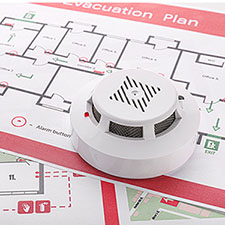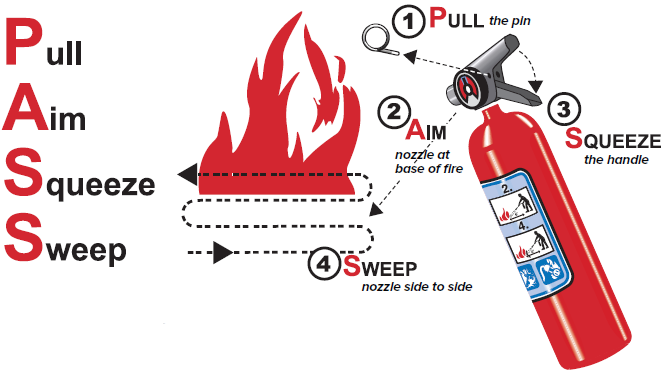Home Fire Prevention

Most fires occur in the home. The leading causes of home fires, home fire injuries and deaths are:
- Cooking equipment
- Heating equipment, including chimneys and space heaters
- Electrical
- Smoking
- Candles
The best way to protect your family from home fires is to make sure that your home has working smoke alarms, a fire escape plan and, if possible, a home fire sprinkler system.
Prevent home fires
Install smoke alarms on each level of your house (including the basement), outside each sleeping area, and inside each bedroom. Test each smoke alarm every month to make sure it is working correctly by pushing the test button with your finger. Replace smoke alarms every 10 years. Gently vacuum your alarms to clean them.
Inspect your home often to look for fire hazards. Ask your local fire department if they can inspect your home.
Prevent the leading causes of fires:
Cooking
More home fires start in the kitchen than in any other place in the house. The leading cause of fires in the kitchen is leaving the kitchen while food is cooking.
- Stay in the kitchen while you are frying, grilling, or broiling food. Turn off the stove if you leave the kitchen for even a short period of time.
- Stay in the home while food is cooking and use a timer to remind you that you are cooking.
- Keep all items that can catch fire — oven mitts, cutting boards, wooden utensils, food packages, paper, towels or curtains — away from your stovetop.
- Keep children away from hot stoves.
- Keep matches and lighters away from children.
Home heating
- Keep children and pets away from space heaters and fireplaces.
- Keep the heater away from things that can burn, such as furniture, rugs or curtains. Follow the manufacturer's advice about installation, placement and use.
- Unplug space heaters when not in use.
- Place heater level and on the floor so it won't tip over. Make sure no nearby items can fall onto the heater and ignite.
- Avoid using ungrounded wiring or extension cords.
Electrical
- Keep electrical appliances and cords out of children's reach.
- Place plastic safety covers over unused wall outlets and extension-cord plugs.
- Avoid overloading outlets. Plug only one high-wattage appliance into an electrical outlet at a time.
Smoking
- Ask people who smoke to do so outside your home and extinguish their smoking material and place it in an appropriate place.
- Stay alert while smoking to avoid unintentional fires.
Candles
- Keep burning candles away from children and pets.
- Keep candles at least 12 inches from anything that can burn.
- Consider using flameless candles in your home.
- Blow out all candles before you leave a room or go to bed.
Have a fire escape plan
Create and practice a home fire escape plan with all family members at least twice a year. This will help your household members react more quickly and safely exit the house in case of a fire.
The plan should include two escape routes from each room in case the door is blocked by smoke or fire. Fire escape routes must be kept clear from clutter. Make sure all security bars (that block outside entry to your house) have quick release devices. All older family members should know how to open them. The fire escape plan should address the special needs of infants and people with disabilities.
When escaping a fire, stay low to the floor, where air is safer. STOP, DROP and ROLL if anyone’s clothes catch on fire. Pick a place that is safe and easy to remember outside your house where family members can meet after they escape.
Safe use of a fire extinguisher
Fire extinguishers should be used cautiously and only for small, contained fires of known origin and after alerting others in the building there is a fire and making sure someone has called the fire department. Do not use a fire extinguisher if you do not know how to use it or what is burning; if you might inhale toxic smoke; if you cannot position yourself with an exit or means of escape at your back; or your instincts tell you not to fight the fire.
Fighting a fire can be dangerous. According to the U.S. Fire Administration Civilian Fire Injuries in Residential Buildings (2017-2019) Report, nationally, about 33 percent of people injured in home fires are hurt trying to control the fire.
The U.S. Fire Administration also provides information on how to choose the right type of fire extinguisher for different kinds of fires.
To operate a fire extinguisher:

Children and the dangers of playing with fire
It is normal for children to be interested in fire. Many children go through a phase where they experiment with fire and matches. Talk to your child about the dangers of playing with fire and not to be afraid of firefighters in uniform.
You can help prevent your child from starting a home fire.
- Guide them to develop a responsible attitude towards fire.
- Teach them the basic facts about fire safety and about the dangers of fire, matches, and lighters. Children who start fires may not understand how dangerous fire can be. Most fires started by children involve a lighter, matches or other open flames.
- Teach children proper techniques for using fire and fire tools safely. Set a good example by using matches, lighters, and fire responsibly.
Fire safety laws in NYS
While most fireworks remain illegal in New York State, some counties and cities outside of New York City have legalized sparklers and certain sparkling devices for those who are over 18 years of age. The New York State Office of Fire Prevention & Control has information about sparkler safety. Consumer fireworks, including sparklers, cause injuries most often to the hands, eyes, head, face, and ears. More than half of these injuries are burns. Sparklers cause most fireworks-related injuries in children.
Rental property owners must install and maintain smoke alarms in rental units- outside of each separate sleeping area, in each room used for sleeping purposes and on every level of the home including basements and cellars.
Children's sleepwear (size nine months to 14 years) that is not tight-fitting must be resistant to flames and self-extinguish if a flame from a candle, match, lighter or a similar item causes the clothing to catch fire. Children's sleepwear includes clothing such as nightgowns, robes, pajamas and loungewear that is made primarily for sleeping. Check the label of your child's sleepwear to make sure it is flame-resistant.
Local partners promoting fire safety
There are proven public health strategies that can prevent home fires and related injuries and deaths. The likelihood of home fires among vulnerable populations populations (the very old, very young, and those with special needs and disabilities) can be reduced through collective education and awareness efforts between public health and fire safety professionals.
Provide education on key messages:
- Vulnerable populations are at higher risk of death from home fires.
- Children must be taught to respect fire danger and practice fire safety.
- Home fires and associated injuries and deaths are preventable.
- Functioning smoke alarms are highly effective in preventing fire-related deaths.
- Fire escape planning and practice prepare residents to quickly and safely exit during home fires.
- Home fire sprinklers quickly detect, contain, and extinguish fires.
The U. S. Fire Administration offers fire prevention campaign materials related to the installation and maintenance of smoke alarms; fire safety for babies and toddlers; fire safety for people over age 50; and smoking and home fires as well as fire safety public service announcements covering a variety of fire safety topics.
Fire services in New York State are highly localized. The best way to determine what services are available in a specific area is to contact the local Fire Chief in your community.
The New York State Office of Fire Prevention and Control's outreach program offers fire safety educator courses that are taught locally and regionally.